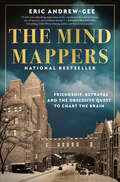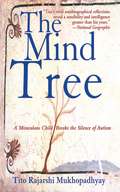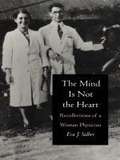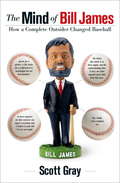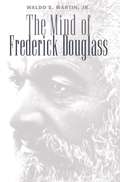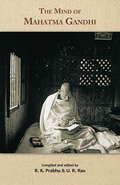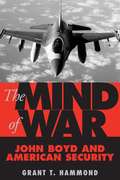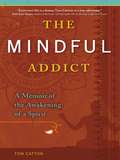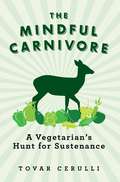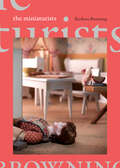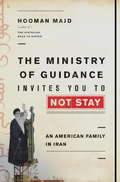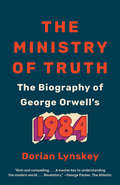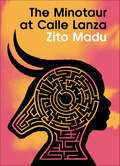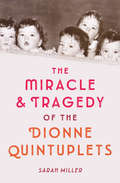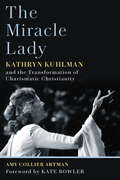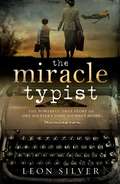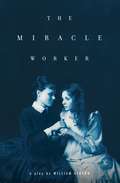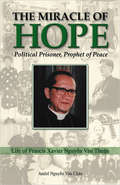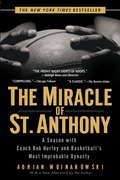- Table View
- List View
The Mind Mappers: Friendship, Betrayal and the Obsessive Quest to Chart the Brain
by Eric Andrew-GeeThe riveting true story of the star-crossed friendship between two neuroscientists—one famous, the other forgotten—who mapped the brain, but lost each other.In the early 1920s, when neurosurgery was more likely to be a death sentence than a cure, two men revolutionized the study of the brain: Wilder Penfield and William Cone. Drawn together by their shared fascination with the &“undiscovered country&” inside our heads, the surgeons formed a partnership and within ten years established the Montreal Neurological Institute in a Gothic stone hospital on the slope of a mountain. The Neuro soon became the world&’s leading centre for neurological study, attracting men and women from across the globe to a booming mid-century city.But their success came at the cost of their friendship.While Cone spent long hours at patients&’ bedsides and in the blood-spattered operating room, Penfield pursued the loftier goal of discovering the seat of consciousness. The Chief, as he was known, went on to develop the Montreal procedure for treating epilepsy, which helped identify the source of speech, executive function and memory in narrow slivers of grey matter—achievements that illuminated the relationship between mind and body, made possible by Cone&’s anonymous work behind the scenes. Over time, their relationship became fraught with personal and professional hurts—and suddenly ended when Cone was found dead in his office at the age of sixty-two.In this compelling dual biography, Globe and Mail journalist Eric Andrew-Gee weaves together the rich history of The Neuro with that of Penfield and Cone to reveal the untold story of one of the birthplaces of neuroscience. In doing so, he breathes new life into a familiar hero and revives the tragic, forgotten story of his partner, writing Dr. William Cone back into the historical record at last.
The Mind Tree: A Miraculous Child Breaks the Silence of Autism
by Tito Rajarshi MukhopadhyayWell-received on initial publication, The Mind Tree is truly an enthralling read. Although he is severely autistic and nearly nonverbal, Tito's ability to communicate through his extraordinary writing is astonishing. At the age of three, Tito was diagnosed with severe autism. But his mother, with boundless hope and determination, read to him and taught him to write in English. She also challenged him to write his own stories. The result of their efforts is this remarkable book-written when he was eight to eleven years old-comprised of profound and startling philosophical prose and poetry. During a New York Times interview, Tito scrawled on a yellow pad, "I need to write . . . It has become a part of me."
The Mind and the Moon: My Brother's Story, the Science of Our Brains, and the Search for Our Psyches
by Daniel Bergner“A profound and powerful work of essential reporting." —The New York Times Book ReviewAn important—and intimate—interrogation of how we treat mental illness and how we understand ourselvesIn the early 1960s, JFK declared that science would take us to the moon. He also declared that science would make the “remote reaches of the mind accessible” and cure psychiatric illness with breakthrough medications. We were walking on the moon within the decade. But today, psychiatric cures continue to elude us—as does the mind itself. Why is it that we still don’t understand how the mind works? What is the difference between the mind and the brain? And given all that we still don’t know, how can we make insightful, transformative choices about our psychiatric conditions?When Daniel Bergner’s younger brother was diagnosed as bipolar and put on a locked ward in the 1980s, psychiatry seemed to have achieved what JFK promised: a revolution of chemical solutions to treat mental illness. Yet as Bergner’s brother was deemed a dire risk for suicide and he and his family were told his disorder would be lifelong, he found himself taking heavy doses of medications with devastating side effects.Now, in recounting his brother’s journey alongside the gripping, illuminating stories of Caroline, who is beset by the hallucinations of psychosis, and David, who is overtaken by depression, Bergner examines the evolution of how we treat our psyches. He reveals how the pharmaceutical industry has perpetuated our biological view of the mind and our drug-based assumptions about treatment—despite the shocking price paid by many patients and the problematic evidence of drug efficacy. And he takes us into the pioneering labs of today’s preeminent neuroscientists, sharing their remarkably candid reflections and fascinating new theories of treatment.The Mind and the Moon raises profound questions about how we understand ourselves and the essential human divide between our brains and our minds. This is a book of thought-provoking reframings, delving into the science—and spirit—of our psyches. It is about vulnerability and personal dignity, the terrifying choices confronted by families and patients, and the prospect of alternatives. In The Mind and the Moon, Bergner beautifully explores how to seek a deeper engagement with ourselves and one another—and how to find a better path toward caring for our minds.
The Mind in Another Place: My Life as a Scholar
by Luke Timothy JohnsonA witness to the peculiar way of being that is the scholar&’s Luke Timothy Johnson is one of the best-known and most influential New Testament scholars of recent decades. In this memoir, he draws on his rich experience to invite readers into the scholar&’s life—its aims, commitments, and habits. In addition to sharing his own story, from childhood to retirement, Johnson reflects on the nature of scholarship more generally, showing how this vocation has changed over the past half-century and where it might be going in the future. He is as candid and unsparing about negative trends in academia as he is hopeful about the possibilities of steadfast, disciplined scholarship. In two closing chapters, he discusses the essential intellectual and moral virtues of scholarly excellence, including curiosity, imagination, courage, discipline, persistence, detachment, and contentment. Johnson&’s robust defense of the scholarly life—portrayed throughout this book as a generative process of discovery and disclosure—will inspire both new and seasoned scholars, as well as anyone who reads and values good scholarship. But The Mind in Another Place ultimately resonates beyond the walls of the academy and speaks to matters more universally human: the love of knowledge and the lifelong pursuit of truth.
The Mind is Not the Heart: Recollections of a Woman Physician
by Eva J. SalberAvailable for the first time in paperback, Eva Salber's The Mind Is Not the Heart (originally published in 1989), is the personal and political story of a white, Jewish, South African woman who practiced medicine for over fifty years among the impoverished--both rural and urban, black and white, in South Africa and later in the United States. Her lifelong dedication to providing health care to poor people was informed by a passionate vision of the link between social problems and medicine, accompanied by an embracing involvement with the communities in which she served. In this warm clear-eyed account, Dr. Salber presents not only her own personal journey, that of a professional woman, teacher, wife, and mother, but also the story of the people on the margins of society among whom she worked.
The Mind of Bill James
by Scott GrayThe first book to chronicle the life and ideas of “the serious baseball fan’s high priest” (New York Times), the impact of his brilliant and entertaining writings, and how someone who never pitched a ball, held a bat, or managed a team fundamentally changed the way baseball is interpreted, analyzed, and even played. Bill James has been called “baseball’s shrewdest analyst” (Slate) and “part of baseball legend” (The New Yorker), and hisBaseball Abstracthas been acclaimed as the “holy book of baseball” (Chicago Tribune). Thirty years ago, James introduced a new approach to evaluating players and strategies, and now his theories have become indispensable tools for agents, statistics analysts, maverick general managers, and anyone who is serious about understanding the game. James began writing about baseball while working at a factory in his native Kansas. In lively, often acerbic prose, he used statistics to challenge entrenched beliefs and uncover surprising truths about the game. His annualBaseball Abstractcaptured the attention of fans and front offices and went on to become a bestselling staple of the baseball book category. In 2002, the Boston Red Sox hired James as an advisor. Two years later they achieved their long-awaited World Series triumph. The Mind of Bill Jamestells the story of how a gifted outsider inspired a new understanding of baseball. It delves deeply into James’s essential wisdom–including his surprising beliefs about pitch counts and the importance of batting-order, thoughts on professionalism and psychology, and why teams tend to develop the characteristics that are least favored by their home parks. It also brings together his best writing, much of it long out of print, as well as insights from new interviews. Written with James’ full cooperation, it is at once an eye-opening portrait of baseball’s virtuoso analyst and a treasury of his idiosyncratic genius.
The Mind of Frederick Douglass
by Waldo E. MartinFrederick Douglass was unquestionably the foremost black American of the nineteenth century. The extraordinary life of this former slave turned abolitionist orator, newspaper editor, social reformer, race leader, and Republican party advocate has inspired many biographies over the years. This, however, is the first full-scale study of the origins, contours, development, and significance of Douglass's thought.Brilliant and to a large degree self-taught, Douglass personified intellectual activism; he possessed a sincere concern for the uses and consequences of ideas. Both his people's struggle for liberation and his individual experiences, which he envisioned as symbolizing that struggle, provided the basis and structure for his intellectual maturation. As a representative American, he internalized and, thus, reflected major currents in the contemporary American mind. As a representative Afro-American, he revealed in his thinking the deep-seated influence of race on Euro-American, Afro-American, or, broadly conceived, American consciousness. He sought to resolve in his thinking the dynamic tension between his identities as a black and as an American.Martin assesses not only how Douglass dealt with this enduring conflict, but also the extent of his success. An inveterate belief in a universal and egalitarian humanism unified Douglass's thought. This grand organizing principle reflected his intellectual roots in the three major traditions of mid-nineteenth-century American thought: Protestant Christianity, the Enlightenment, and romanticism. Together, these influences buttressed his characteristic optimism. Although nineteenth-century Afro-American intellectual history derived its central premises and outlook from concurrent American intellectual history, it offered a searching critique of the latter and its ramifications. How to square America's rhetoric of freedom, equality, and justice with the reality of slavery and racial prejudice was the difficulty that confronted such Afro-American thinkers as Douglass.
The Mind of Mahatma Gandhi
by M. K. GandhiOnly now and again does there arise above the common level some rare spirit, who, having thought about God more deeply, reflects more clearly the divine purpose and puts into practice more courageously the divine guidance. The light of such shines like a strong beacon on a dark and disordered world. Gandhi belongs to the race of the prophets who have the courage of the heart, the courtesy of the spirit and the laughter of the unafraid. Through his life and teaching, he bears testimony to the values for which this country has stood for ages, faith in spirit, respect for its mysteries, the beauty of holiness, the acceptance of life’s obligations, the validity of character, values which are neither national nor international, but universal. … There is so much misunderstanding today about Gandhi’s views and ways of thinking. This book, where we find collected together the relevant extracts from Gandhi’s own writings on the central principles of his faith and conduct, will help to make Gandhi’s position clearer to the modern mind. [From Foreword, 1945] S. Radhakrishnan
The Mind of St. Paul
by William BarclayFrom the Preface: These chapters originally appeared as a series of weekly articles in the pages of The British Weekly. ... To the original series I have added two chapters, one on Sin and the other on the Church in the thinking of Paul. These chapters do not in any way claim to be an exhaustive and complete Theology of Paul. I have simply gone direct to the Pauline letters to find out what Paul said and thought on certain great subjects. Their aim will be fulfilled, if they send people back to the reading of Paul's letters themselves. This is a well-documented presentation of Paul's ideas. It is easy to read and quite interesting.
The Mind of War: John Boyd and American Security
by Grant HammondThe ideas of US Air Force Colonel John Boyd have transformed American military policy and practice. A first-rate fighter pilot and a self-taught scholar, he wrote the first manual on jet aerial combat; spearheaded the design of both of the Air Force's premier fighters, the F-15 and the F-16; and shaped the tactics that saved lives during the Vietnam War and the strategies that won the Gulf War. Many of America's best-known military and political leaders consulted Boyd on matters of technology, strategy, and theory.In The Mind of War, Grant T. Hammond offers the first complete portrait of John Boyd, his groundbreaking ideas, and his enduring legacy. Based on extensive interviews with Boyd and those who knew him as well as on a close analysis of Boyd's briefings, this intellectual biography brings the work of an extraordinary thinker to a broader public.From the Trade Paperback edition.
The Mindful Addict
by Tom CattonThe enlightening and worldly journeys of a once hopeless addict whose life was profoundly changed after a chance meeting with a nomadic spiritual healer.
The Mindful Carnivore: A Vegetarian's Hunt for Sustenance
by Tovar CerulliA vegan-turned-hunter reignites the connection between humans and our food sources and continues the dialog begun by Michael Pollan and Barbara Kingsolver. While still in high school, Tovar Cerulli experimented with vegetarianism and by the age of twenty, he was a vegan. Ten years later, in the face of declining health, he would find himself picking up a rifle and heading into the woods. Through his personal quest, Tovar Cerulli bridges disparate worldviews and questions moral certainties, challenging both the behavior of many hunters and the illusion of blamelessness maintained by many vegetarians. In this time of intensifying concern over ecological degradation, how do we make peace with the fact that, even in growing organic vegetables, life is sustained by death? Drawing on personal anecdotes, philosophy, history and religion, Cerulli shows how America's overly sanitized habits of consumption and disconnection with our food have resulted in so many of the health and environmental crises we now face.
The Minds of Billy Milligan
by Daniel KeyesReconstructs the case of a young man who was arrested in 1977 as the Ohio "campus rapist." Under psychiatric observation he was found to possess twenty-four distinct personalities, including those of a lesbian, a painter, an Englishman, an escape artist, a con man, and a small deaf boy.
The Miners' Strike: Miners' Strike (Images of the Past)
by Mark Harvey Mark Metcalf Martin JenkinsonIn addition to being the most bitter industrial dispute the coalminers' strike of 1984/5 was the longest national strike in British history. For a year over 100,000 members of the National Union of Mineworkers, their families and supporters, in hundreds of communities, battled to prevent the decimation of the coal industry on which their livelihoods and communities depended. Margaret Thatcher's government aimed to smash the most militant section of the British working class. She wanted to usher in a new era of greater management control at work and pave the way for a radical refashioning of society in favour of neo-liberal objectives that three decades later have crippled the world economy.Victory required draconian restrictions on picketing and the development of a militarised national police force that made widespread arrests as part of its criminalisation policy. The attacks on the miners also involved the use of the courts and anti-trade union laws, restrictions on welfare benefits, the secret financing by industrialists of working miners and the involvement of the security services. All of which was supported by a compliant mass media but resisted by the collective courage of miners and mining communities in which the role of Women against Pit Closures in combating poverty and starvation was heroic. Thus inspired by the struggle for jobs and communities an unparalleled movement of support groups right across Britain and in other parts of the world was born and helped bring about a situation where the miners long struggle came close on occasions to winning.At the heart of the conflict was the Yorkshire region, where even at the end in March 1985, 83 per cent of 56,000 miners were still out on strike. The official Yorkshire National Union of Mineworkers (NUM) area photographer in 1984-85 was the late Martin Jenkinson and this book of his photographs some never previously seen before - serves as a unique social document on the dispute that changed the face of Britain.As featured in The Yorkshire Times, Sheffield Telegraph and NUJ News Leeds.
The Miniaturists
by Barbara BrowningIn The Miniaturists Barbara Browning explores her attraction to tininess and the stories of those who share it. Interweaving autobiography with research on unexpected topics and letting her voracious curiosity guide her, Browning offers a series of charming short essays that plumb what it means to ponder the minuscule. She is as entranced by early twentieth-century entomologist William Morton Wheeler, who imagined corresponding with termites, as she is by Frances Glessner Lee, the “mother of forensic science,” who built intricate dollhouses to solve crimes. Whether examining Honey, I Shrunk the Kids, the Schoenhut toy piano dynasty, portrait miniatures, diminutive handwriting, or Jonathan Swift’s and Lewis Carroll’s preoccupation with tiny people, Browning shows how a preoccupation with all things tiny can belie an attempt to grasp vast---even cosmic---realities.
The Ministry of Guidance Invites You to Not Stay
by Hooman MajdWith U.S.-Iran relations at a thirty-year low, Iranian-American writer Hooman Majd dared to take his young family on a year-long sojourn in Tehran. The Ministry of Guidance Invites You to Not Stay traces their domestic adventures and closely tracks the political drama of a terrible year for Iran's government. It was an annus horribilis for Iran's Supreme Leader. The Green Movement had been crushed, but the regime was on edge, anxious lest democratic protests resurge. International sanctions were dragging down the economy while talk of war with the West grew. Hooman Majd was there for all of it. A new father at age fifty, he decided to take his blonde, blue-eyed Midwestern yoga instructor wife Karri and his adorable, only-eats-organic infant son Khash from their hip Brooklyn neighborhood to spend a year in the land of his birth. It was to be a year of discovery for Majd, too, who had only lived in Iran as a child. The book opens ominously as Majd is stopped at the airport by intelligence officers who show him a four-inch thick security file about his books and journalism and warn him not to write about Iran during his stay. Majd brushes it off--but doesn't tell Karri--and the family soon settles in to the rituals of middle class life in Tehran: finding an apartment (which requires many thousands of dollars, all of which, bafflingly, is returned to you when you leave), a secure internet connection (one that persuades the local censors you are in New York) and a bootlegger (self-explanatory). Karri masters the head scarf, but not before being stopped for mal-veiling, twice. They endure fasting at Ramadan and keep up with Khash in a country weirdly obsessed with children. All the while, Majd fields calls from security officers and he and Karri eye the headlines--the arrest of an American "spy," the British embassy riots, the Arab Spring--and wonder if they are pushing their luck. The Ministry of Guidance Invites You to Not Stay is a sparkling account of life under a quixotic authoritarian regime that offers rare and intimate insight into a country and its people, as well as a personal story of exile and a search for the meaning of home.
The Ministry of Truth: The Biography of George Orwell's 1984
by Dorian Lynskey"Rich and compelling. . .Lynskey&’s account of the reach of 1984 is revelatory.&”--George Packer, The Atlantic An authoritative, wide-ranging, and incredibly timely history of 1984--its literary sources, its composition by Orwell, its deep and lasting effect on the Cold War, and its vast influence throughout world culture at every level, from high to pop.1984 isn't just a novel; it's a key to understanding the modern world. George Orwell's final work is a treasure chest of ideas and memes--Big Brother, the Thought Police, Doublethink, Newspeak, 2+2=5--that gain potency with every year. Particularly in 2016, when the election of Donald Trump made it a bestseller ("Ministry of Alternative Facts," anyone?). Its influence has morphed endlessly into novels (The Handmaid's Tale), films (Brazil), television shows (V for Vendetta), rock albums (Diamond Dogs), commercials (Apple), even reality TV (Big Brother). The Ministry of Truth is the first book that fully examines the epochal and cultural event that is 1984 in all its aspects: its roots in the utopian and dystopian literature that preceded it; the personal experiences in wartime Great Britain that Orwell drew on as he struggled to finish his masterpiece in his dying days; and the political and cultural phenomena that the novel ignited at once upon publication and that far from subsiding, have only grown over the decades. It explains how fiction history informs fiction and how fiction explains history.
The Minotaur at Calle Lanza
by Zito MaduIn the fall of 2020, as the pandemic raged around the globe, Zito Madu traveled to Venice for a writing fellowship. There, he found a deserted, silent, but still beautiful city, “one of those extraordinarily strange places in the world.” As he details his walks through a haunted landscape, we learn about his family’s immigration from Nigeria to Detroit, his troubled relationship with his father, his meditations on race and otherness, the small joys of daily life and solitude, and his own rage and regret. With nods to Calvino and Borges, and reminiscent of Teju Cole, The Minotaur at Calle Lanza is an unforgettable travel memoir about the mysterious transformations that may lurk inside us all.
The Miracle & Tragedy of the Dionne Quintuplets: Five Children Who Captivated The Entire World
by Sarah MillerIn this riveting, beyond-belief true story from the author of The Borden Murders, meet the five children who captivated the entire world. <P><P>When the Dionne Quintuplets were born on May 28, 1934, weighing a grand total of just over 13 pounds, no one expected them to live so much as an hour. Overnight, Yvonne, Annette, Cécile, Émilie, and Marie Dionne mesmerized the globe, defying medical history with every breath they took. In an effort to protect them from hucksters and showmen, the Ontario government took custody of the five identical babies, sequestering them in a private, custom-built hospital across the road from their family--and then, in a stunning act of hypocrisy, proceeded to exploit them for the next nine years. <P><P>The Dionne Quintuplets became a more popular attraction than Niagara Falls, ogled through one-way screens by sightseers as they splashed in their wading pool at the center of a tourist hotspot known as Quintland. Here, Sarah Miller reconstructs their unprecedented upbringing with fresh depth and subtlety, bringing to new light their resilience and the indelible bond of their unique sisterhood.
The Miracle Lady: Kathryn Kuhlman and the Transformation of Charismatic Christianity
by Amy Collier ArtmanA smart, powerful, charismatic preacher brought back to lifeOn October 15, 1974, Johnny Carson welcomed his next guest on The Tonight Show with these words: “I imagine there are very few people who are not aware of Kathryn Kuhlman. She probably, along with Billy Graham, is one of the best-known ministers or preachers in the country.” But while many people today recognize Billy Graham, not many remember Kathryn Kuhlman (1907–1976), who preached faith and miracles to countless people over the fifty-five years of her ministry and became one of the most important figures in the rise of charismatic Christianity.In The Miracle Lady Amy Collier Artman tells the story of Kuhlman’s life and, in the process, relates the larger story of charismatic Christianity, particularly how it moved from the fringes of American society to the mainstream. Tracing her remarkable career as a media-savvy preacher and fleshing out her unconventional character, Artman also shows how Kuhlman skillfully navigated the oppressive structures, rules, and landmines that surrounded female religious leaders in her conservative circles.
The Miracle Typist
by Leon SilverIn the tradition of THE TATTOOIST OF AUSCHWITZ, a heartbreaking true story of love, loss and survival against all odds during the Second World war. Conscripted into the Polish army as Hitler&’s forces draw closer, Jewish soldier Tolek Klings vows to return to his wife, Klara, and son, Juliusz. However, the army is rife with anti-Semitism and Tolek is relentlessly tormented. As the Germans invade Poland, he is faced with a terrible dilemma: flee home to protect his family – and risk being shot as a deserter – or remain a soldier, hoping reports of women and children being spared by the occupying forces are true. What follows is an extraordinary odyssey that will take Tolek – via a daring escape from a Hungarian internment camp – to Palestine, where his ability to type earns him the title of &‘The Miracle Typist&’, then on to fight in Egypt, Tobruk and Italy. A broken telegram from Klara, ending with the haunting words, &‘We trouble&’, makes Tolek even more determined to find his way home and fulfil his promise. This heartbreakingly inspiring true story is brought vividly to life by Tolek&’s son-in-law, Melbourne writer Leon Silver.
The Miracle Worker: A Play
by William GibsonNO ONE COULD REACH HER Twelve-year-old Helen Keller lived in a prison of silence and darkness. Born deaf, blind, and mute, with no way to express herself or comprehend those around her, she flew into primal rages against anyone who tried to help her, fighting tooth and nail with a strength born of furious, unknowing desperation. Then Annie Sullivan came. Half-blind herself, but possessing an almost fanatical determination, she would begin a frightening and incredibly moving struggle to tame the wild girl no one could reach, and bring Helen into the world at last....
The Miracle of Father Kapaun: Priest, Soldier, and Korean War Hero
by Roy Wenzl Travis HeyingFather Emil Kapaun is a figure whose heroism during the Korean War still serves as a lamp to guide our feet on the path of life. Under the unbelievably brutal conditions of a prisoner of war camp, survivors say, no matter their religion Father Kapaun did more to save lives and maintain morale than any other man they know. In tracking down the story of Father Kapaun for the Wichita Eagle, Wenzl and Heying uncovered a paradox. What truly constitutes sainthood? Do we have it within ourselves? Father Kapaun was posthumously awarded the United States' highest military recognition, the Medal of Honor. The citation for it reads, in part, "Chaplain Emil J. Kapaun repeatedly risked his own life to save the lives of hundreds of fellow Americans. His extraordinary courage, faith and leadership inspired thousands of prisoners to survive hellish conditions, resist enemy indoctrination, and retain their faith in God and country."
The Miracle of Hope
by Van Chau Andre NguyenWritten by a friend of Cardinal Van Thuan, this biography chronicles the life of the man Pope John Paul II said was "...marked by a heroic configuration with Christ on the cross."
The Miracle of St. Anthony
by Adrian WojnarowskiIn a city mired in endless decay, where the youth suffer through all the horrors of urban blight, hope comes in a most unassuming form: a tiny brick schoolhouse run by two Felician nuns where a singular basketball genius takes teenagers from the mean streets of Jersey City and turns them into champions on the hardcourt. Coach Bob Hurley had been working miracles at St. Anthony High School for over thirty years, winning state and national championships and offering his players rescue from their surroundings through college scholarships, when he met his most dysfunctional team yet. In The Miracle of St. AnthonyAdrian Wojnarowski follows Hurley through a gripping and heartrending season as he struggles to lead a troubled team to glory through his unparalleled understanding of the game and his ceaseless determination to see no more children lost to these streets. In The Miracle of St. Anthony, acclaimed sports journalist Adrian Wojnarowski follows Hurley through a gripping and heartrending season, as he struggles to lead a troubled team to glory through his unparalleled understanding of the game and his ceaseless determination to see no more children lost to the city streets. Acclaim for The Miracle of St. Anthony: "It takes two ingredients to make a book special: a great story and a great storyteller. The Miracle of St. Anthonyhas both. Bob Hurley is a remarkable coach; Adrian Wojnarowski is his equal as a writer. " -JOHN FEINSTEIN, BESTSELLING AUTHOR OF A SEASON ON THE BRINK "Takes you through this miracle season where this high school basketball team didn't have the greatest talent but somehow came out on top . . . [Coach Hurley] is dedicated to these city kids and helping them overcome the obstacles that the city can offer. A lot of his lessons are not about basketball, but about life, and doing things the right way. " -BILL RAFTERY, THE WALL STREET JOURNAL "Compelling. " -Chicago Tribune "A classic. " -Boston Globe "Astonishing" -New York Post "Hard to put down. " -The Washington Post
